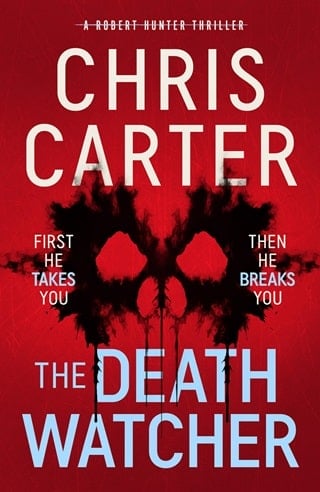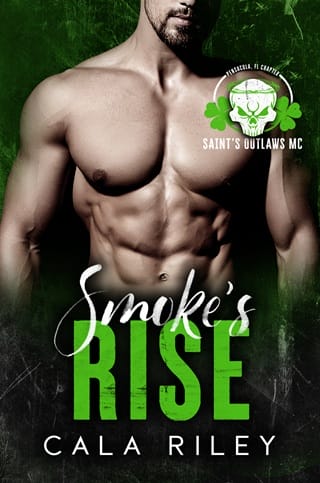Chapter Three
Seconds after Captain Blake had left their office, Hunter called the Chief Medical Examiner for the LA County – Dr. Carolyn Hove. At the time of the call, Dr. Hove was just about to start a new post-mortem examination, but she explained that she would be free to talk in about an hour's time, so straight after lunch, Hunter and Garcia took a quick trip to the Department of Medical Examiner-Coroner in North Mission Road.
After making their way up the lavish steps that led to the main entrance of the impressive old hospital-turned-morgue, they entered the lobby and approached the reception counter. The attendant, a kind-faced, African American woman in her mid-fifties, greeted them with a very well-rehearsed, courteous smile.
‘Good afternoon, Detectives.'
‘Good afternoon, Sandra,' Hunter and Garcia replied at the same time, both of them returning the smile.
Sandra had been with the Department of Medical Examiner for over thirteen years.
‘How are you doing today?' Hunter asked.
‘I'm OK, thank you.'
Hunter knew that the question wouldn't be returned. None of the department receptionists ever asked anyone entering the morgue how they were doing, regardless of who they were.
‘Here to see Dr. Hove?' Sandra asked, already checking her computer screen.
‘That's right,' Hunter replied, quickly consulting his watch. ‘She told us that she'd probably be free around this time.'
Sandra gave both detectives a renewed smile. ‘Perfect timing. She just finished an autopsy about five minutes ago. I'll buzz her for you.'
Hunter and Garcia waited while Sandra had a quick ten-second conversation on the phone.
‘Dr. Hove will meet you in Autopsy Theater Four,' she said, as she instinctively indicated the double swinging doors to the right of the reception counter.
Hunter and Garcia thanked her, pushed through the doors and carried on down the long, squeaky-clean, white corridor. At the end of it, they turned right into a shorter corridor, where two empty gurneys were pushed up against the left wall.
Hunter pretended to be scratching his nose, but what he was really doing was cupping his hand over it, as the smell of those corridors got to him every time. It was like a smell with a hidden punch – and that hidden punch packed some serious power. Hunter didn't mind it at first, many years ago, but the more he visited the morgue, the more he noticed it… and the more he noticed it, the more it bothered him because, no matter what, that smell could only be associated with one thing – death.
As they walked past the gurneys, they turned right again. Autopsy Theater Four was the first set of double doors on the right. Hunter pushed them open and he and Garcia stepped inside a room that was chilled to a few degrees below comfortable. This was a small autopsy theater when compared to theaters one, two and three, with only one stainless-steel examination table that sprang out of a long counter that ran along the east wall. On the ceiling, directly above the examination table, there was a large, circular, surgical light, which was already turned on, bathing the room in warm brightness. The west wall was completely made of cold metal storage crypts, which looked more like large filing cabinets with bulky handles than anything else. The interesting fact was that the strong smell from the corridors was a little less intrusive inside the autopsy theater.
Tall and slim, with penetrating green eyes and in her traditional long, white lab overcoat, Dr. Hove stood at the other side of the empty examination table. Her long chestnut hair was rolled up into a simple bun at the top of her head.
‘Robert, Carlos.' She greeted each detective with a subtle nod. ‘I'm guessing you're here about the file I sent Barbara early today, right? Male victim, found up in the Sierra Pelona Mountains?'
‘You knew that Captain Blake would come to us with that file, didn't you, Doc?' Garcia asked, a quirky smile on his lips.
Dr. Hove replied with an eyebrow-lift. ‘I admit that this victim doesn't exactly fall under the category of ultra-violent crimes, but it's certainly a very intriguing case, and I know that the two of you like "intriguing", so yes, I was pretty sure that Barbara would take the file to you first.'
‘Well,' Garcia said, as he and Hunter approached the autopsy table. ‘The COD was definitely something different.'
‘Yes, it was,' Dr. Hove agreed. ‘That and a few minor details that just didn't sit right, you know?'
‘Really?' Hunter asked. ‘Like what else?'
‘Here,' she said, her head tilting in the direction of the metal crypts. ‘Let me show you.'
Hunter and Garcia followed Dr. Hove over to the theater's west wall and waited while she opened the door to compartment 3C, before rolling out the body stored inside it. It lay inside a white, plastic body bag. Dr. Hove pulled the zipper from head to toe, splitting the bag open to reveal the body in its entirety. Shaun Daniels had been an average man in height, but a little slight in weight.
Live and up close, his facial lacerations were even more shocking than how the pictures that Hunter and Garcia had looked at just over an hour ago had shown. The body's left eye socket seemed to be out of level with its right one – a little deeper and certainly fractured. His nose, completely twisted out of shape and scraped down, had also clearly been broken. Despite the body having been found days ago, his face, hands and feet still showed signs of swelling. His skin looked rubbery and porous, but instead of ghostly white, it had taken on an odd shade of purple, which made it harder to see the large number of bruises that graced most of his body.
‘I wasn't supposed to have been the ME in this post-mortem,' Dr. Hove explained. ‘Seemingly apparent CODs, like hit-and-runs, bullet to the head, suicide and so on, are always assigned to one of the several advanced classes we run in conjunction with UCLA forensic pathology degrees. These types of corpses often go to students, but due to some paperwork error at the university, it ended up here. I was supposed to have been in a meeting all morning today, but the meeting got canceled. To help out with the backlog of autopsies, I took a couple on this morning.' She nodded at the body on the slab. ‘This was the second one.'
Dr. Hove stayed quiet for a moment, allowing both detectives to quickly study the body in front of them. Hunter was the first to pick up on something odd.
‘He's missing four of his toenails on his left foot,' he said, frowning at the doctor, who smiled back at him.
‘Good eye, Robert,' she said, with a nod. ‘That was one of the clues that something about this hit-and-run didn't feel quite right.'
Garcia, who was still studying the victim's facial lacerations, quickly moved his attention to the corpse's feet. ‘What the hell?'
Hunter thought back to the photos that he and Garcia had looked at in their office. It took him just a second to remember.
‘He was wearing sneakers,' he said, his gaze settling on Dr. Hove. ‘On the photos in the file you sent us, Doc, he was wearing sneakers.'
Dr. Hove nodded in silence.
‘Do you have them?'
‘In the storage room,' she confirmed. ‘His nails weren't inside it, if that's why you're asking.'
‘This can't be a consequence of being hit by a car, Robert.' Garcia shook his head.
‘I know,' Hunter accepted. ‘The reason I asked is because there's no way that he was walking around wearing sneakers, with no toenails on his left foot. Too painful.'
‘He wasn't,' Dr. Hove confirmed. ‘He was dead before he got to the spot where he was found.'
Hunter scratched his chin. ‘How long before? What's the time of death?'
The doctor quickly reached for her notes. ‘According to the traffic incident report, his body was discovered by the side of the road at around 5:10 a.m., on Sunday, June 16th. That's four days ago.'
‘That's correct,' Hunter confirmed.
‘Well,' Dr. Hove continued. ‘He was dead at least six to eight hours before that time, but not longer than eighteen.'
‘So he died sometime on Saturday afternoon/evening,' Garcia queried, ‘not on Sunday morning?'
‘That's right.'
A couple of silent seconds followed the doctor's revelation.
‘But according to the LAPD Traffic Division,' Garcia again, ‘and your autopsy report, his injuries are consistent with a pedestrian being run over by a car at speed.'
‘They are indeed.' The doctor nodded at the detectives.
‘OK,' Garcia countered. ‘But there's no way that he was run over by a car sometime on Saturday evening and no one saw the body lying there, by the side of the road, until 5:10 a.m. on Sunday morning. Lake Hughes Road might not be the busiest of roads, but it's busy enough. It links Santa Clarita to Lancaster through the Sierra Pelona Mountains. Traffic might die down late at night and in the early hours of the morning, but you would still get cars crossing over every couple of minutes or so.'
‘Like I said,' Dr. Hove insisted. ‘The compound fractures, together with all the bruising, the damage to the cranium, the scraped skin and the torn clothing, are all consistent with him being struck by a car at speed, but…' Her eyebrows arched again.
‘But the accident could've been staged to mask the state that the body was already in.' Hunter completed the unfinished sentence. ‘And by "staged" I mean – there was no accident at all. The perp could've easily created the skid marks on the road, using his truck, and simply left the body there.'
‘Very much so,' Dr. Hove agreed. ‘The assumption of a hit-and-run accident here was purely circumstantial – the body was found on the road, at a location that showed some pretty hard-braking skid marks against the asphalt. The distance between the body and the skid marks were consistent with the pedestrian being hit by a vehicle traveling at around fifty miles per hour—'
‘But that can be easily calculated.' Garcia, this time.
‘Correct again,' the doctor confirmed. ‘There was nothing at the scene that indicated foul play, so very understandably, anyone wouldn't really think twice before assuming that the body on the road was there due to a hit-and-run accident.'
Hunter shifted his attention back to the body's feet. ‘You said that the missing toenails were one of the clues to the fact that something about this hit-and-run didn't feel right. What were the others? The skin color?'
‘That was another, for sure,' the doctor replied. ‘This purply shade that his skin has taken on can be caused by a number of different factors – loss of body heat is one of them. His face, hands and feet also show signs of swelling, but not as a consequence of a fracture, which is odd.' Her head bowed in the direction of the body. ‘But the main clues here are the comminuted open fractures – both of them.'
Hunter and Garcia studied the fractures for several long seconds.
‘There's a lack of ecchymosis.' Hunter spoke first.
‘Bang on the money,' Dr. Hove agreed. ‘There's no bruising… no hematomas directly around the wound, where blood vessels were clearly severed from such severe trauma. If his blood circulation was normal at the time those fractures occurred, ecchymosis would've appeared all around the wound, like you can see around the nail plates on his toes.'
‘So what you're really saying here is,' Garcia shot back first, ‘that he was alive when he lost his toenails, but already dead by the time he fractured his wrist and leg?'
‘That's what the necropsy evidence is showing us, yes,' the doctor agreed. ‘Which indicates that the perp didn't just create the tire skid marks on the road, and simply leave the body there, like Robert suggested.'
‘He actually ran him over,' Hunter corrected himself. ‘Causing the compound fractures… but that happened way after he was already dead.'
Dr. Hove nodded. ‘That's why the lack of ecchymosis. But that's not all. He also has three fractured ribs, six broken fingers, three on each hand, and a fractured eye socket – the left one. Those, on the other hand, occurred while he was alive.'
Hunter once again studied the victim's feet before moving over to his hands. Most of the nails on all of his fingers, including his thumbs, were either chipped or broken. Despite the purple hue that the victim's skin had taken on, Hunter saw no indications of frostbite, nor on his toes or on his fingers, but he also knew that frostbite wasn't a prerequisite for hypothermia, which could also occur in temperatures that weren't considered bitterly cold. That was usually due to the person being wet, sweaty, trapped in cold water, lacking any kind of unnatural body-heat insulation (clothes) or a combination of those. The fact that Shaun Daniels's body fat seemed to be on the low side would've also slightly accelerated the hypothermic process. All in all, there were indeed some indicators to hypothermia, but Hunter knew that Dr. Hove would've needed something a lot more concrete to justify her findings.
‘So what led you to conclude that the ultimate cause of death was hypothermia, Doc?' he asked.
‘Good question, Robert,' the doctor replied, her head angling slightly left. ‘Because that was where things got a little trickier.'
‘Why is that?' Garcia, this time.
‘Well, the identification of hypothermia as a COD has always been somewhat problematic in the field of forensic pathology. In the majority of cases, our biggest indication to hypothermia comes from circumstantial evidence – the person is found in the snow, or submerged in freezing water, etcetera. It was precisely the lack of evidence that got me looking for different possibilities. The purpling of the skin, together with the swelling of the face, hands and feet, can indeed be caused by hypothermia, but it can also be caused by—'
‘Poisoning.' Hunter beat her to the punch.
‘Exactly,' the doctor agreed, her index finger pointing at him. ‘Which sounded like a much more plausible alternative for a COD, given that we are in California and right at the beginning of summer.'
‘Poisoning sounds fair,' Garcia commented.
‘That was what I was looking for,' Dr. Hove continued. ‘Signs of poisoning, when I discovered multiple black spots in his gastric mucosa.'
‘Are you talking about Wischnewski spots?' Hunter asked.
‘The one and the same.'
Garcia chuckled. ‘I'm not even surprised that you know what they call black spots in someone's gastric mucosa, what boggles my mind is that you actually know how to pronounce that.'
Hunter shrugged. ‘I read a lot.'
‘And there it is,' Garcia's hand came up in a ‘what can you do?' gesture.
‘Wischnewski spots are considered one of the most reliable and important features in identifying hypothermia,' Dr. Hove carried on. ‘I was very surprised to find them, which obviously prompted me to search for supportive links to fatal hypothermia – hemorrhages into the synovial membrane, bloody discoloration of synovial fluid of the knee… and other details.'
‘And they were all present?' Hunter asked.
‘All of them.' The answer came with a firm nod before she, once again, indicated the body. ‘Ultimately, his heart gave up, but I have no doubt that the reason behind his heart failing was hypothermia.' Dr. Hove slipped off her latex gloves and threw them in the disposing container. ‘So yes, as crazy as this might sound, this man has frozen to death… in Los Angeles… in mid-June.'
 Fullepub
Fullepub 



